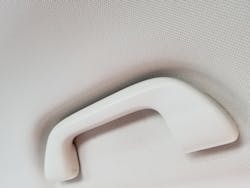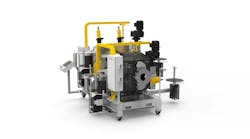This story appeared in the Winter 2020 edition of Plastics Recycling.
Additives can significantly improve the prospects for recycled plastics, be they polyethylene (PE), polyethylene terephthalate (PET) or polypropylene (PP), as new products from FRX Polymers, Songwon, Ampacet and Clariant illustrate.
FRX Polymers
FRX Polymers, Chelmsford, Mass., says its halogen-free flame retardants provide an unusual secondary benefit — they can significantly improve the processability and physical properties of recycled PET in a broad spectrum of end uses.
Nofia flame retardants enhance the properties and processability of recycled PET in foam applications for the building, construction and mass transportation markets, says Ina Jiang, vice president of sales and marketing at FRX Polymers. Similar results have been found in injection-molding compounds based on recycled PET blended with Nofia flame retardants.
Companies’ sustainability efforts have been hampered because recycled PET can exhibit poor mechanical performance and processability compared with virgin PET. In addition, mechanical properties often deteriorate further when other additives, such as flame retardants, are added, FRX says.
However, the company says its Nofia flame-retardant additives act as chain extenders when added to recycled PET feedstocks. Unlike other flame retardants, the Nofia additives repair the PET chain and increase its intrinsic viscosity, according to the company.
FRX says it has helped customers that produce nonwoven textiles for the automotive industry increase recycled PET content from 50 percent to as much as 97 percent. Formulations with 97 percent recycled PET include a 3 percent loading of Nofia flame retardants for textiles containing 3,300 parts per million (ppm) phosphorus content. For 6,300 ppm phosphorus content textiles, a formulation containing 94 percent recycled PET and 6 percent Nofia flame retardants is used. Previous formulations consisted of only 50 percent recycled PET.
Manufacturers of automobile interiors and fabrics that are used in homes and public settings use the flame retardants.
“It will be bedsheets, curtains [and] upholstery fabric that is used mostly in public settings like hotels, train stations, airport terminals, stadiums and even schools,” Jiang says.
Nofia flame retardants replace halogenated flame retardants, which are being phased out because of toxicity concerns. FRX produces them using chemical products and processes that reduce or eliminate the generation of hazardous substances.
Songwon
A new stabilizer from additives manufacturer Songwon Industrial Co. Ltd. is designed to improve the quality and performance of recycled PP while extending its service life.
The company, which is headquartered in Korea with U.S. operations in Friendswood, Texas, says it designed Songxtend 2721 for use in automobile parts. It enhances the mechanical properties and improves long-term heat stability of recycled PP, so the material can be used in under-the-hood applications, including engine covers, cable ducts and battery housings. When recycling PP battery cases, the additive also minimizes the negative effect of acid residues.
The company also says it has collaborated with Berry BPI Group, the U.K-based division of Berry Global, Evansville, Indiana, to develop heavy-duty bags made from recycled PE to package its products. The 44-pound-capacity bags contain 50 percent recycled PE; Songwon’s goal is to increase the recycled content to 80 percent without compromising quality.
“We’ve identified the major global issues relating to plastics as well as industry trends and are focused on providing targeted solutions that signal both our confidence in plastic as a material and our aim to develop more sustainable and safer additive solutions within the plastic materials segments,” says Olivier Keiser, corporate sustainability officer at Songwon.
Ampacet and Clariant
Two recently released additives help to improve the recycling prospects for film. With their new products, Ampacet, Tarrytown, N.Y., and Swiss specialty chemicals company Clariant International Ltd. take aim at giving polyolefins a longer life.
Ampacet recently launched its ReVive compatibilizer masterbatch, which is a blend of functional additives that aids in recycling polyolefin barrier films, including those made from PE and PP. ReVive allows postindustrial and postconsumer barrier film scrap to be recycled. Normally, oxygen barrier layers contaminate the recycling stream.
Doreen Becker, the company’s sustainability director, says, “ReVive helps to minimize the environmental impact of barrier film packaging and can help [consumer packaged goods] brands use more recycled materials in their packaging to achieve sustainability goals.”
For polyolefin film scrap that contains an oxygen barrier and/ or ethylene vinyl alcohol barrier resins, ReVive can be added at ratios of 3 percent to 5 percent to maintain good flow properties and improve processing.
As an example of ReVive’s benefits, Ampacet points to research involving PE film scrap. Adding a 5 percent concentration of ReVive to a blend of PE and nylon reduces haze from 55 percent to 18 percent and increases gloss from 18 gloss units to 43 gloss units. Laboratory studies demonstrate that ReVive also improves the optical properties of film produced with recycled content, the company says.
“The compatibilizer enables the material to disperse better — it enables the EVOH [ethylene vinyl alcohol] and the nylon to disperse more finely into the polyethylene matrix … thereby maintaining the optical properties and the physical properties of the multilayer film,” says Jim Morrison, Ampacet strategic business manager. “That’s the function of the compatibilizer, to allow EVOH … to be compatibilized in a polyethylene matrix so you can get more and more recycle into a polyethylene layer of a multilayer film.”
Clariant, with its U.S. headquarters, Clariant Corp., in Charlotte, North Carolina, says its AddWorks PKG 906 Circle polymer stabilizer allows polyolefin film manufacturers to increase the use of recycled resin from manufacturing scrap in their products.
The additive can help film makers meet their sustainability and business goals by allowing them to reduce waste, consume less virgin resin and increase production efficiency, according to the company.
The polymer stabilizer allows producers to boost the use of recycled content in PP and PE films by as much as 30 percent, without any loss of performance or reduction of processing efficiency, the company says. It is particularly well-suited for biaxially oriented PP film, but it also is applicable to cast and blown film processes. The stabilizer prevents yellowing and gel formation in these applications.
“Our additives can help to increase recycling yields and avoid degradation, odor and discoloration,” says Stephan Lynen, head of Clariant’s additives business unit. “We will continue to develop additives that increase the reuse potential of industrial and consumer waste.”
AddWorks PKG 906 Circle is the first Clariant product to carry the “Circle” designation, which the company introduced to highlight new products that have been specifically designed to deliver significant benefits for reusing or recycling plastics.
Bruce Geiselman, senior staff reporter
For more information:
Ampacet Corp., Tarrytown, N.Y., 914-631-6600, www.ampacet.com
Clariant Corp., Pratteln, Switzerland, 704-331-6673, www.clariant.com
FRX Polymers Inc., Chelmsford, Mass., 978-244-9500, www.frxpolymers.com, [email protected]
Songwon Industrial Co. Ltd., Friendswood, Texas, 281-648-1585, www.songwon.com






